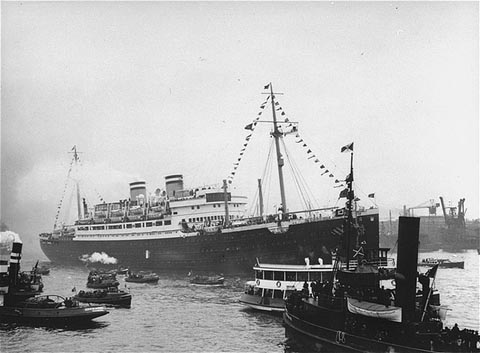From the first days of Nazi rule on, the Jewish religious communities and other Jewish organisations found themselves in an entirely new situation. They had to organise social care for their ever-poorer members, provide them with advice and help and support emigration. In 1933, the most important Jewish organisations had already managed to bridge their ideological differences - in particular those between the German assimilationalists and the Zionists - and to create a new umbrella organisation - Reichsvertretung der deutschen Juden (Reich Representation of German Jews). It was headed by the distinguished liberal rabbi Leo Baeck.
Before 1933, the fall in the relative and absolute number of Jews in Germany had been the result of the increased aging of the Jewish population and a fall in the birth rate. After the Nazis seized power, however, the falling number of Jews in Germany was due above all to emigration. Between 1933 and 1939 the number of Jews in Germany fell by a full 289 000people, in other words more than half the Jewish population from1933. An estimated 250 000 Jews emigrated from Germany during this period.
The extent of emigration differed from year to year in accordance with the varying degrees of persecution, as well as the opportunities of being accepted and founding a new life in target countries. In 1933, under the influence of the Nazi seizure of power, a total of 40 000 Jews left Germany, most of them young and single or politically-involved. In subsequent years the number of emigrants fell with a certain amount of regularity, not increasing markedly until 1938 and 1939, when German Jews lost any remaining illusions regarding the possibility of finding a modus vivendi with the Nazi regime. From the start of the war in September 1939, opportunities to emigrate fell rapidly, and it became more and more difficult for emigrants to find target countries willing to accept them.
|
Year |
Number |
|
1933 |
27 000 |
|
1934 |
23 000 |
|
1935 |
21 000 |
|
1936 |
25 000 |
|
1937 |
23 000 |
|
1938 |
40 000 |
|
1939 |
78 000 |
|
1940 |
15 000 |
|
1941 |
8000 |
|
Total |
270 000 |
(Source: Deutsch-jüdische Geschichte in der Neuzeit. Band IV: Aufbruch und Zerstörung, 1918-1945, p. 227.)
In terms of target country, most refugees headed for Palestine (over 50 000 in all) and to European countries. The United States hindered immigration of German Jews by issuing various administrative decrees, and in the 1930s the US quota for the number of immigrants from Germany was not even filled. It was only in 1938 and 1939 that the US started to allow greater numbers of refugees.

It became harder and harder for emigrants to find a target country. A well-known case is that of the St. Louis, a ship that set sail for Cuba in May 1939 with over 900 refugees from Germany on board. Before it could reach Cuba, its permission to land was rescinded by the Cuban authorities. Despite diplomatic efforts, the refugees were not allowed to enter Cuba, or the US, and the St. Louis had to set out back for Europe. Finally the UK, Netherlands, Belgium and France were persuaded to take the passengers of the St. Louis. However, many of them were overtaken by the final solution to the Jewish question
after some of these countries were occupied. The photo shows the St. Louis at anchor at the port of Havana. (Photo: Herbert Karliner, courtesy of USHMM Photo Archives)
Jewish organisations supported emigration and tried to ensure that emigrants were as well-prepared as possible for life in their new country, organising language and retraining courses. A number of young people passed through Hachshara - agricultural training in the countryside organised by Zionists ahead of expected emigration to Palestine. The leaders of the Jewish community also tried to ensure that emigration went smoothly, and tried to prevent panic from spreading and people from emigrating without the necessary preparation.
The Nazi authorities did support the emigration of Jews, since it corresponded to their aim of ridding Germany of its alleged enemies, but at the same time they tried to take as much property as possible from the fleeing Jews. Thus impoverished, German Jews had much greater difficulty finding asylum in some target countries. In 1933, Zionist organisations managed to conclude the Haavara Agreement with the Nazis. This stated that emigrants to Palestine who had to leave property in Germany would import German goods into Palestine in return, after which they would receive a large part of their original property back.
The structure of the Jewish community in Germany also changed under the influence of Nazi persecution. Given that it was mostly young people who were emigrating, there was an ever-increasing proportion of old people who could not or did not want to leave Germany. At the same time, the position of Jews in the countryside and small towns worsened considerably, since they were much more exposed to everyday bullying and were easy to isolate. Many of them thus preferred to leave for the large cities, where they hoped to become more anonymous, and at the same time would be able to rely on the support of the large Jewish community. According to the census of May 1939, a total of 330 892 people of Jewish faith lived in the German Reich, including Austria. More than 55 % of them lived in three large cities: Berlin, Vienna and Hamburg.
-
Literature:
-
Barkai, Avraham and Mendes-Flohr, Paul. Deutsch-jüdische Geschichte in der Neuzeit. Band IV: Aufbruch und Zerstörung, 1918-1945. München: C. H. Beck, 1997. 429 p.